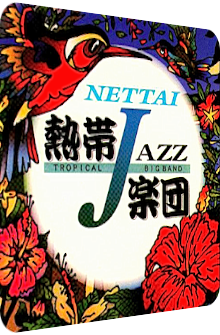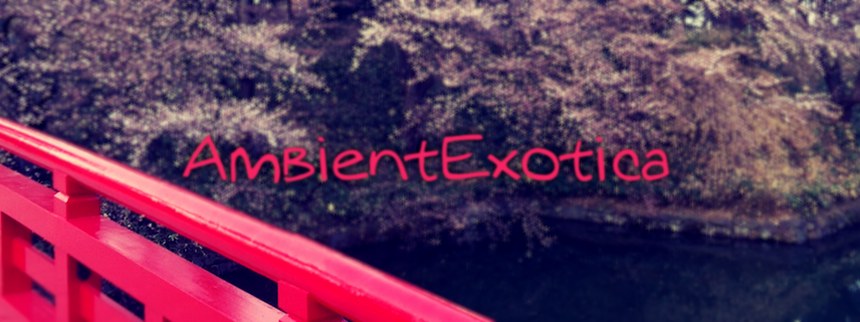
Nettai Tropical Jazz Big Band
September
1999
If Exotica fans are asked about the best contemporary exotic big band, the answer rightfully mentions bandleader Brian O' Neill's brass-fueled incarnation of Mr. Ho's Orchestrotica. While this answer will not change in the near future, there are options available, such as Big Kahuna & The Copa Cat Pack, the brassified Waitiki 7+7 project or, as this review is hopefully going to prove, the imaginatively named Nettai Tropical Jazz Big Band; with such a band name, you surely cannot do too many things wrong. And this is indeed the case here, as this Japanese ensemble, led by Carlos Kanno, merges original cuts with the wildest Latinized yet highly tropical renditions of classic material you may possibly find, including the Exotica gemstones Flamingo and Caravan!
The album I am going to review is unsurprisingly called September, was released in 1999 on the RMM label, and features a whopping 20+ musicians who are gathered in order to present ten wonderful jungles or compositions that reside in close proximity to the lush greenery. Not coincidentally does the album carry the particular month of September as its sole title, as the large combo delivers a fantastic take on the eponymous classic of the Pop band Earth Wind & Fire. And believe me, the big band twists and turns this ditty around and creates a tropical version that oscillates between the Samba and the Mambo sides of life. September remains one of my absolute favorites, as the imaginative arrangements create vivacious atmospheres that are eminently enthralling. Read more about this virtually unknown classic below, and prepare for exhilarative things to come.
Grand. Pompous. Nettai! The album opens with a humongously Latinized version of Lalo Schifrin's Mission Impossible Theme. Transformed into Misión Imposible to set the prospect right, it is a gorgeous take with hammering piano stabs, screeching jungle flutes, liquid bongos and acidic brass blasts. Sure, the novelty factor is thin nowadays, as this melody has been interpreted gazillions of times, but the revved up percussion layer is still welcome and unique, as it expands the tropical vista of this piece. Despite the orchestral feeling, there are many quiet scenes where the exotic percussion is allowed to shine, and don't get me started on the improvised urbanized concrete jungle segue with all its funky saxophones and sleazy piano tercets. Schifrin's epic piece has finally arrived in the Tropics.
The following eponymous September is really that radio anthem by Earth, Wind & Fire, but luckily surprises here with a magnificently eupeptic soundscape. The saxophone is mellow and spreads glee and blitheness, the brass eruptions in the background amicable and the piano tones good-natured. The occasional rising show tune intermissions boost the scope further. This is admittedly no genuine Exotica piece in either version, but the admixed maracas and golden-shimmering aura make it come terrifically close. Even if you despise this Pop standard with a passion, give this euphonious fanfare a go!
Once Obatalá starts, things are getting serious, if only for the fact that this is the first unique piece on the album, written by band member Hideaki Nakaji. It surprises with a Mambo-esque structure, a hand clap-interspersed Brazilian percussion scheme with city-strolling piano cascades, a brassy interplay between all horn players and an embracing, totally benign atmosphere with additional obatalá chants. It is the kind of convivial big band motif that never lets the jazzy scope out of sight; this becomes apparent in the many free-flowing sections where the Latinized piano droplets are meshed with the lead saxophone, causing an almost minimal effect due to the otherwise incessantly maintained soundcarpet. The Japanese guys know how to do it right!
Vintage Exotica fans will rejoice at the next song: Duke Ellington's Caravan is presented, and as expected, the band goes all-in on the epicurean mood and dismisses a gentle, all too cozy setting. Shawm-like trumpets, an aqueous piano aorta as well as a cowbell-infused clave-ennobled bongo percussion make this an overexposed, but by no means inappropriate interpretation. Hell, there is even a short intersection of Henry Mancini's Peter Gunn Theme thrown in, totally crazy! The majesty of the original is blasted away, only the sunset-dried piano chords in unison with the horns can evoke the thermal heat of a mirage for a short time. Caravan has success written all oer it. Taisei Aoki's Azul is next, and it is here where the Nettai Tropical Jazz Big Band goes dreamy. A lead pianica – an instrument similar to a harmonica – evokes a French rustic savoir vivre, the balmy piano sprinkles work well in tandem with the languorous brass section, and the tempo is decidedly slowed down. The only dynamic element are the short sound waves of the cymbals. Due to the lacunar structure with many fissures of which the decay can ooze out, the setting is more nightly than on any other tune of the album.
Peter Cor's and Louis Silas Jr.'s Earth Wind & Fire hymn Getaway follows next and brings back a postmodern Samba rhythm with show tune-like brassy staccato rotors, polyphonous hooks and an upwards spiraling euphony that is totally catchy. This rendition is tremendously catchy, energetic and one of the tunes where the brass instruments are used in an even broader fashion than before. The Latin piano is inferior, the many cowbells audible, but altogether negligible as well. It is the gargantuan brass flourishes that make this rendition so great. There are even hints of a spy theme attached to it, although the band shies away from injecting the ultimate spy theme everyone knows. Hideaki Nakaji's second contribution follows, the aptly titled Mia Terra Natal: sunset-evoking piano chords and a particularly upfront percussion scheme conflate with romantic, sugarless trumpet notes. The setting depicts an orange-colored coast scenery without ever succumbing to kitschy terrains. As the song progresses, the arrangements gets brassier, but the band finds the right balance between dreaminess and more upbeat realms.
Thank the tiki gods for the inclusion of Ted Grouya's eternal anthem Flamingo! And thank the band for including it in the roster. Although I am strongly preferring the symphonic reverie of Andre Kostelanetz or the tropical glitz of Martin Denny and Ted Auletta, the Nettai Tropical Jazz Big Band boosts the upbeat structure of this classic with male vocals, vivid staccato brass backings and legato intersections. Since this is a vocal version, with the English lyrics sung by band leader Carlos Kanno himself, these verses of course carry much of the composition, but the allotted instrumental sections provide an equally essential part. The exotic percussion creek adds further tropical traits that are usually missing in the orchestral versions. Of particular success are the Latin chants in the middle of the rendition, lessening the enchantment of the Tropics in favor of a hot-blooded Salsa. This morphing range of styles is a great addition to an already stellar version. Utterly great!
The penultimate Rendez-Vous expands the jungle setting with a pristine, purified piano phantasmagoria and rattling, fizzling percussion layers. The dirty sax works great in juxtaposition to the high-plasticity bongos and silky shakers. Oscillating between a poeticizing rain forest and a Manhattan skyline show tune, Rendez-Vous unleashes many great hooks and riffs, but continues to maintain the snugness of the opening section, even though the jumpy piano tones and world-embracing horn stabs evoke a much livelier panorama. The outro comprises of Shiro Sasaki's Leyenda. It is noteworthy for its propeller-like drum opening and gargantuan clarion brass quakes which lead to a double bass-backed sunburst of a brazen luminescence, underpinning piano chords that move into Latin territories later on. The percussion is revved up as well, and even though the composition never unleashes a frantic, ritualistic atmosphere, the thicker percussion adds vividness to the already neon-colored brass-scape. The melodies are not carved out all too well in my opinion, but that is where the multifaceted percussion comes in handy. A good closer to a huge Exotica album.
I lack the knowledge of pinpointing or coining the exact term that perfectly describes why Japanese artists or combos are so great in their delivery of Latin material. One word that comes to mind is oversaturation. While this description seems to inherit a negative impetus, I use it in a glaringly positive way: vivid brass sections are especially stimulating, dreamy pianos tranquilize the listener, and once a splendid melody is injected, rest assured that it is able to outshine the lucency of the sun! This is a remarkably amicable and convivial take on Latin music. No shades, dubious cacophonies or lamenting traces can be found. The mood, curiously enough, does not get tiresome, as sleazy spy theme settings and aquatic coast dioramas are skillfully placed in-between the tropical Jungle theme. As important as the brass sections is the percussion. The album is chock-full of bongos, congas, cowbells and maracas, always providing the link to exotic realms and brightly lit jungles.
Be it the elevation of the bland Pop material of Earth Wind & Fire, Lalo Schifrin's grandiloquently Latinized Misión Imposible, the awe-inspiring vocal version of the old Exotica classic Flamingo or the dreamy material from the feathers and hearts of the band members, September is a superb album that is as accessible to Jazz novices as it is adrenaline-boosting to Exotica afficionados. Despite its bold Latin doses and tropical structure, this album of the Nettai Tropical Jazz Big Band remains curiously under the radar, as does the band itself. The continental distinction continues to be maintained in the music-related world, which is an utter pity. I highly advice you to check this CD out, which is admittedly hard due to import prices and the lack of digital versions in music download stores in most countries. But it is so worth it. YouTube at least stores a few cuts at time of writing this review. Carlos Kanno and Co. deliver big time with their second work and first studio album.
Exotica Review 153: Nettai Tropical Jazz Big Band – September (1999). Originally published on Dec. 1, 2012 at AmbientExotica.com.
